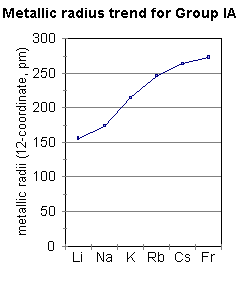
Home
Common Compounds
Exam Guide
FAQ
Features
Glossary
Construction Kits
Companion Notes
Just Ask Antoine!
Simulations
Slide Index
Toolbox
Tutorial Index
Introduction
Measurement
Matter
Atoms & ions
Compounds
Chemical change
The mole
Gases
Energy & change
The quantum theory
Electrons in atoms
| The periodic table |
Solids
Liquids
Solutions
Acids & bases
Redox reactions
Reaction rates
Organic chemistry
Everyday chemistry
Inorganic chemistry
Environmental chemistry
Laboratory
History of chemistry
Miscellaneous
Home  FAQ FAQ  The periodic table The periodic table | Print | Comment |
| Previous Question | Next Question |
Which element has the largest atoms?
- What is the largest atom (in terms of volume not atomic mass or weight)?
9/21/99 -
Cesium (Cs), tucked in the lower left hand corner of the table, has the largest known atoms. The atomic radius of Cs is given variously as 273.1 pm [1], 265 pm [2], 265.5 pm [3] or 260 pm [4]. Rubidium also has large atoms, but its atomic radius is almost 30 pm less than cesium's.
Vocabulary atomic radius 
effective nuclear charge
lanthanide contraction
pm
valence electron
valence shell
Why are cesium atoms so big? Cesium has a large valence shell and a relatively low effective nuclear charge. The valence shell (the outer 'peel' of the atom) is largest in atoms at the bottom of the periodic table. A low nuclear charge means that electrons can wander further, on average, from the nucleus. Nuclear charge increases going left to right across table rows, so the largest atoms should be found on the left edge of the table.
Does having such large atoms make any difference in cesium's properties? Yes. Cesium is one of the most reactive elements known, partially because its atoms are so large. Cesium's lone valence electron is so far away from the nucleus on average that it is very easily removed. The electron is taken from cesium by other substances in violent chemical reactions. Cesium bursts into flames on contact with oxygen in air. Water and even ice reacts more violently with cesium than any of the other common metals:
2 Cs(s) + 2 H2O(
 )
)  2 CsOH(aq) + H2(g)
2 CsOH(aq) + H2(g)
Why aren't francium atoms the biggest? The usual periodic trend for atomic size places larger atoms at the left of a row and towards the bottom of a column on the periodic table. It's no surprise that cesium is large. But shouldn't francium, in the next period with an even larger valence shell, be even larger?
The answer is "possibly, but we just don't know yet." Francium isn't easy to study. It's the least stable of the first 103 elements; the most stable Fr isotope has a half-life of just 22 minutes [5]. The distance between atoms in metallic francium has not yet been measured.
 How can we predict the atomic radius of francium?
We can try to predict unknown properties by extrapolating the properties of its 'brothers and sisters' in the same family.
The simple extrapolation of the atomic radius trend for the alkali metals in the graph at left suggests that francium is definitely a contender for largest atom. However, as a period 7 element, francium is subject to a phenomena called the "lanthanide contraction". Elements with filled 4f subshells are smaller than might otherwise expected. The intervention of the lanthanides increases the effective nuclear charge, which offsets the size increase expected from filling the n=6 valence shell. As a consequence, sixth period transition metals are about the same size as their fifth period counterparts. The lanthanide contraction may make
francium's atoms only slightly larger than those of cesium. In fact, they may even be slightly smaller.
How can we predict the atomic radius of francium?
We can try to predict unknown properties by extrapolating the properties of its 'brothers and sisters' in the same family.
The simple extrapolation of the atomic radius trend for the alkali metals in the graph at left suggests that francium is definitely a contender for largest atom. However, as a period 7 element, francium is subject to a phenomena called the "lanthanide contraction". Elements with filled 4f subshells are smaller than might otherwise expected. The intervention of the lanthanides increases the effective nuclear charge, which offsets the size increase expected from filling the n=6 valence shell. As a consequence, sixth period transition metals are about the same size as their fifth period counterparts. The lanthanide contraction may make
francium's atoms only slightly larger than those of cesium. In fact, they may even be slightly smaller.
References
- N. W. Alcock, Bonding and Structure (Ellis Horwood, 1990). Alcock's radius is a 12-coordinate metallic radius taken from Teatum,E., Gschneidner,K., & Waber,J. (1960) "Compilation of calculated data useful in predicting metallurgical behaviour of the elements in binary alloy systems", LA-2345, Los Alamos Scientific Laboratory.
- T. Moeller, Inorganic Chemistry: A Modern Introduction (Wiley: New York, 1982).
- M. Winter, WebElements. The Cs-Cs bond length is taken from L.E. Sutton (ed.) in Table of interatomic distances and configuration in molecules and ions, Supplement 1956-1959, Special publication No. 18, Chemical Society, London, UK, 1965.
- M. Winter, WebElements. From Slater's empirical atomic radius compilation, J.C. Slater, J. Chem. Phys. 1964, 39, 3199.
(The Orozco Group, SUNY-Stony Brook) 
Current research and facts about francium, the most unstable element of the first 103.
http://fr.physics.sunysb.edu/francium_news/frconten.htm (9/21/99)
General Chemistry Online! Which element has the largest atoms?
Copyright © 1997-2010 by Fred Senese
Comments & questions to fsenese@frostburg.edu
Last Revised 02/23/18.URL: http://antoine.frostburg.edu/chem/senese/101/periodic/faq/what-atom-is-largest.shtml